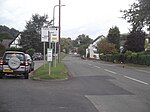Dinmore Manor
Christian monasteries established in the 12th centuryCountry houses in HerefordshireEnglish Gothic architecture in HerefordshireHorse farms in the United KingdomNorman architecture in England ... and 1 more
Preceptories of the Knights Hospitaller in England

Dinmore Manor House is a large rural house in a well-wooded, hilly part of Herefordshire in the least populous parish of the county, Dinmore. It was substantially rebuilt in late 16th century, altered around 1830 and extended around the year 1928. The main house is a Grade II listed building. The outlying chapel is mostly medieval and is grade II* listed.
Excerpt from the Wikipedia article Dinmore Manor (License: CC BY-SA 3.0, Authors, Images).Dinmore Manor
Dinmore Manor Lane,
Geographical coordinates (GPS) Address Nearby Places Show on map
Geographical coordinates (GPS)
| Latitude | Longitude |
|---|---|
| N 52.1487 ° | E -2.753 ° |
Address
Dinmore Manor Lane
Dinmore Manor Lane
HR4 8EE , Dinmore
England, United Kingdom
Open on Google Maps








